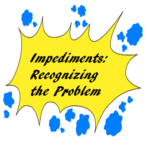 This second post in the series on handling impediments builds on the process described in Handling Impediments: Why it Matters! I’ll dive into the first step: recognizing the problem.
This second post in the series on handling impediments builds on the process described in Handling Impediments: Why it Matters! I’ll dive into the first step: recognizing the problem.
Recognizing that there is a problem is the first step. Often there is only a signal, so you have to be a good listener to pick it up. Some examples of signals, which are usually a symptom of a deeper problem, that you can hear on the work floor are:
- The priorities are changing all the time, this isn’t workable.
- My work is done, I’m waiting for other people.
- The R&D manager just dropped in, we need to do some other work.
- I’m too busy, I can’t join the stand-up.
- We can only deliver on time if we skip the retrospective.
Do they sound familiar? When I teach teams to become more effective in handling impediments I see a lot of recognition in the classroom (there’s been several times where somebody stated that they heard something similar yesterday at work). Signals like this can be heard, and when you hear them you need to deal with them.
Sometimes I meet people that do not want to hear bad news. “I hired to solve problems, not to bring them up!” is what I have heard people (often managers) say. Ignoring problems doesn’t make them go away. Some problems can be solved by the team itself, for other problems they will need the help of their manager.
There has to be a mindset in the organization where “having a problem is not a problem”. If there’s a problem, when would you like to know? Usually as soon as possible, to limit potential damage. Solving problems before they go out of hand is usually also cheaper 🙂
People should not be blamed when they bring up problems. So don’t shoot the messenger! At one conference a presenter stated that “at our company we never shoot the messenger, unless (s)he is late ;-)”. Even in that case I would not shoot them, but you may want to do a root cause analysis to find out what took them so long…
Summing up, if you want to deal with impediments then make sure to keep your ears and eyes open to catch any signals that are there. Make it very clear that people can come to you if something is bothering them or when they see a problem.
In the next blog post I will dive into analyzing and understanding impediments. Stay tuned!



Hi Ben,
It won’t surprise you that I see a in your blog a description of a phase of my Crucial Dialogue Model. Indeed in the middle of the model stands the Question Mark, i.e. the problem. As you pointed out, and as JFK once said, every problem is in fact an opportunity. So it depends of your FOR if you see the signals as pointing to a problem and/or an opportunity.
The first phase of my Crucial Dialogue Model is called Communication, i.e. authentic interaction regarding the Problem/Opportunity. The corresponding behaviors/tools are the ‘definition of the Problem/Opportunity’, ‘Advocacy and Inquiry’ (how I/you ‘see’ the problem), Non verbal communication (the ‘power’ of non -verbal’s) and Confirmed Paraphrasing (to make sure we’ve fully understood the problem e.g. deciphering the non-verbal’s).
During this phase we ‘understand’ the problem, this does not mean that we’ve ‘appreciated’ correctly the problem/opportunity. This should be accomplished during the second phase. I assume that this will be covered in your next blog ☺.
Creatively,
Johan
Just wanted to point out that ‘my’ Crucial Dialogue model is based on Creative Interchange, the Mother of all Models, including ‘Handling Impedents’.
Hi Johan,
This blog on recognizing the problem fits within Crucial Dialogue model. It’s a first step where I urge people to be open at all times to catch signals. Signals in itself are not good or bad, they are a trigger telling you that there is more information.
I dedicated a blog to “recognizing” because I see a lot of missed signals and hence problems that are dealt with late, or opportunities that are missed and go out of existence. When I dive deeper there are usually culture issues where people don’t feel safe to speak up (but still give a signal for those who want to know). Or where problems are almost systematically ignored as people feel that they don’t have time for them. Where everybody knows there’s a problems but nobody wants to be the messenger.
This kind of behavior is ineffective, it hurts team working, frustrates people, and has a huge impact on the products or services for our customers.
I’m hoping that this blog post inspires people to deal with problems and opportunities as early as possible. Recognizing is the first step. Analyzing and understanding follows, my next blog in this series will dive into that.